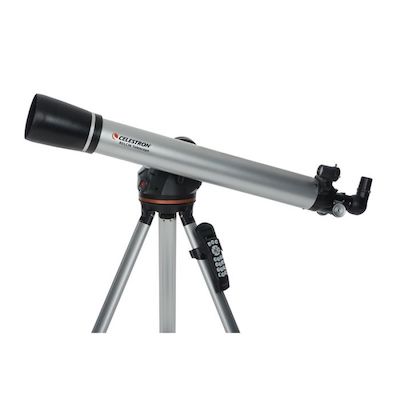The Optical Tube
Optically, the Celestron 80LCM is an 80mm f/11 Fraunhofer achromatic refractor with a focal length of 900mm, which uses two lens elements made of crown and flint glass. With f/11 being a rather long focal ratio, you should expect to see marginal amounts of chromatic aberration, but not enough to seriously mar the image quality as shorter achromats tend to have. The long focal ratio also makes it easier for the telescope to “snap” into focus due to the larger depth of field. Unsurprisingly, the 80LCM delivers sharp, mostly color-free images of the Moon, planets, double stars, and a few of the brighter deep-sky objects that are accessible with 80mm of aperture.
The focuser on the 80LCM is a 1.25” rack and pinion design, as with all of the LCM telescopes. While largely made of plastic, it works pretty well provided you don’t use any really heavy eyepieces, which one probably won’t be doing as a high-quality eyepiece with lots of heavy lens elements will cost nearly as much as the entire telescope.
The 80LCM attaches to its mount with a short, Vixen-style dovetail. Due to its stubbyness, the dovetail does not allow one to slide the telescope forward or backward to compensate for any front- or back-heaviness, so you won’t be able to use any heavy eyepieces, Barlow lenses, or cameras (not that the focuser or mount would be happy with that anyway). The orientation of the dovetail also means that if you try to place the scope on an equatorial mount, the focuser and finder will be rotated 90 degrees from where you want them, which is rather annoying.
Accessories
The 80LCM comes with two eyepieces: 25mm and 9mm Kellners providing 36x and 100x, respectively. While Kellners are not terrible eyepieces, they are about the cheapest you can get and Celestron’s don’t come with eyeguards, making positioning one’s eye correctly a bit tricky, especially for a novice.
The included star diagonal for the 80LCM is the same plastic, erect-image Amici prism diagonal Celestron often uses on their lower-priced telescopes. It works okay, but has annoying glare problems, seems to provide a bit of a dim image, and can induce an annoying diffraction spike on bright stars. It will also vignette with a wide-field, low-power eyepiece such as a 32mm or 40mm Plossl. I really dislike this diagonal – there’s no need for a correct left-right view in an astronomical telescope, especially one that can’t even be pointed by hand anyway. I wish Celestron could just include a regular prism diagonal that isn’t as low quality.
The 80LCM includes the same StarPointer red-dot finder as many Celestron telescopes. It is decent, and all you need it for is to align the GoTo mechanism anyway, but the bracket it’s on is a strange, nonstandard unit that’s built into the focuser and prone to breaking or preventing the finder from being aligned properly. I don’t get why it’s so hard to just include the standard red-dot base, or alternatively, a real interchangeable base and Vixen-style finder shoe, both of which are more adaptable and durable than what the 80LCM comes with.
The Celestron Lightweight Computerized Mount
The LCM, or Lightweight Computerized Mount (which is on par with Celestron’s “Star Locating Telescope” or SLT for “most boring and generic mount name ever”), is a stripped-down, extremely cheapened version of the other Celestron computerized mounts. Unlike the SLT and almost all other Celestron mounts, the LCM uses plastic rather than metal gearing, which makes it prone to stripping, backlash, and inaccuracy. While tracking at high power, the mount actually twitches or bounces back and forth due to the extremely low quality of the gears. As a result, even planetary astrophotography might be difficult with this mount.
In addition to the aforementioned plastic gears, the LCM suspends the telescope off to the side of the center of gravity and outboard from the altitude axis, meaning the telescope is always liable to tip over and the load is not distributed remotely evenly on the tripod. This tripod, by the way, is made out of thin, rectangular aluminum tubes and wobbles with the slightest breeze or touch. It also completely lacks any sort of spreader or accessory tray, which is crucial to keeping a lightweight mount stable. The stability of this telescope and mount is a complete joke, and a beginner would find themselves extremely frustrated with attempting to even get a star alignment, let alone observe anything themselves – or heaven forbid, try to show something to others with the telescope. With some DIY work and creativity, you could probably fill the legs with sand, or otherwise beef it up to be a bit more stable, but a scope costing as much as the 80LCM should not need this kind of work to be useful – it should function right out of the box.
What can you see?
The 80LCM’s small aperture means that it doesn’t have much light grasp to show you deep-sky objects. It primarily excels at viewing the Moon and planets, along with a handful of double stars, bright nebulae, and star clusters. However, none of these objects are particularly difficult to find, which raises the question: why bother with GoTo for this sized telescope, let alone on a wobbly and somewhat expensive mount?
Should I buy a used 80LCM?
If you’re willing to tinker and can get it for under $100, sure. But keep in mind that it’s a bit of project scope and certainly not worth much.

